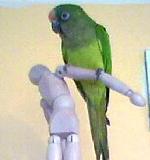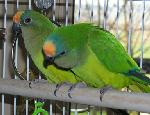Welcome to the
Peach-Fronted Page!
Name: Peach-Fronted Conure (Aratinga Aurea)
Description: General plumage is green with the forehead, front of the crown, and area immediately surrounding the eye area orange. The back of the crown and parts of the nape are a dull blue. The cheeks, throat, and upper breast are a pale olive-brown with the lower breast, abdomen, under tail-coverts, and under wing-coverts a yellowish-green. The tips of the primaries and primary-coverts are bluish with the outer webs of the secondaries blue. The underside of the tail and flight-feathers are an olive-yellow. Periophthalmic Ring is whitish with an orangish-red Iris. Immatures are the same as adults, but without the orange area around the eye, and the Iris is dark. The beak is blackish and the feet are grey. Length is 26 cm (10 inches) with a wing length of 133 - 152 (5 - 6 inches). Immatures are colored similar to adults but without the orange area around the eye and have a darker Iris. All Conures are not sexually dimorphic and must be DNA or surgically sexed.**
In The Wild: Found in pairs and small groups of 4 to 8 birds, or flocks of 20 to 30 birds. They spend days on trees or foraging on the ground. Their call is a shrill screech, especially during flight. Can be found in open, dry to semi-arid flat country and savanna areas with cactus, bushes, and trees as well as along edges of the forest, near settlements, in parks, and cultivated areas and gardens.
Breeding Information: Breeding season usually begins in Spring but is also possible during the winter. A clutch usually consists of 3 to 4 eggs. The incubation period is an average of 23 days. The fledging period is approximately 50 days. Several breedings a year are possible. Their eggs measure 27.4 x 22.0 mm (1.08 x 0.87 inches).
Temperament: Intelligent and occasionally noisy Conure. They are hardy and not difficult to keep. Noisy in the early morning and late afternoon or when when alarmed. They quickly become accustomed to their owners. Like most Conures, they are hard chewers so a supply of fresh branches and twigs are recommended.**
Diet: This should consist of Pellets, a good Seed Mix (Safflower, Oats, some Sunflower--also sprouted--Hemp, Buckwheat, Canary Seed, and various Millets), lots of Fruit and Vegetables (such as apple, mango, cucumber, carrots, and rowanberries), and Greens. White bread and eggfood for rearing. Diets may vary so you should consult your Veterinarian.
** (Please note that not all birds are the same and may vary somewhat in Temperament and Plumage.)
Created by Rio
Designs
Champaign, Illinois



